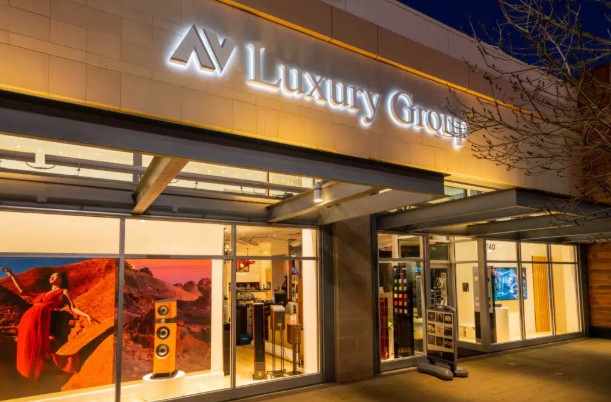As physical stores compete with the convenience of e-commerce, retail giants are transforming shopping from a transactional activity into an immersive experience. The key driver behind this shift? Audiovisual (AV) innovation. From massive LED video walls to dynamic soundscapes and interactive digital signage, AV technology has become a strategic tool to captivate audiences, strengthen brand identity, and drive sales.
Today’s consumers, particularly Gen Z and Millennials, value experience over mere products. They expect retail spaces that entertain, inspire, and tell stories. By integrating advanced AV systems, leading brands are not just displaying products—they’re creating multisensory environments that turn shopping into engagement.

AV Luxury Group
Over the last decade, the concept of “experiential retail” has reshaped the brick-and-mortar landscape. Major brands are moving away from static displays toward immersive storytelling spaces that merge creativity, technology, and interactivity.
Take Nike House of Innovation or Apple’s flagship stores as examples. These environments seamlessly blend LED displays, motion graphics, and synchronized lighting to create a living brand narrative. Shoppers don’t just browse; they participate. The goal is no longer to sell a shoe or a phone—it’s to make customers feel part of a lifestyle.
This transformation underscores the power of audiovisual design: to spark emotion, deepen engagement, and make every visit memorable.
Modern AV ecosystems encompass much more than a single screen or speaker. Retailers are adopting an array of technologies to connect physical and digital realms in real time.
Large-scale LED video walls have become the signature of premium retail environments. These displays deliver ultra-high brightness, fine pixel pitch, and vibrant color that remains visible under intense ambient light. In flagship stores, they serve as digital storytelling canvases—showcasing campaigns, product demos, or immersive brand visuals.
Transparent LED screens further blur the line between advertising and architecture, allowing stores to showcase visuals without blocking visibility into the space.
Interactive kiosks and touch-enabled screens let customers browse inventory, customize products, or access promotions instantly. Retailers like Adidas and L’Oréal use these displays to enable personalized journeys—bridging online convenience with in-store experience. Such tools not only enhance engagement but also collect valuable behavioral data.
Sound plays a subtler but equally powerful role in shaping perception. Curated background music, directional audio, or ambient sound zones help retailers design moods that complement their brand identity. The result is an emotional environment—calm, energetic, luxurious, or futuristic—that subconsciously influences purchase behavior.
Nike’s flagship stores in New York, Shanghai, and Paris deploy massive LED displays and motion-reactive systems to showcase athletes and community stories. When customers test products, the visuals synchronize to their movements, transforming the store into a performance arena. This blend of interactivity and storytelling directly fuels brand engagement and loyalty.
Luxury fashion houses like Louis Vuitton and Burberry use high-resolution LED screens and holographic projections to animate window displays. Each campaign becomes a moving artwork, attracting passersby and boosting foot traffic. These dynamic visuals replace traditional mannequins with living narratives.
IKEA integrates digital signage throughout its showrooms to guide shoppers and highlight seasonal offers. Beyond marketing, these displays improve navigation and operational efficiency—enabling real-time updates across global locations.
At Starbucks’ flagship stores, synchronized light, visuals, and music are designed to reflect coffee-making rituals. The result is an immersive environment that celebrates craft and culture, deepening customers’ emotional bond with the brand.
Retailers investing in AV are seeing measurable ROI across multiple metrics:
Moreover, digital displays offer operational advantages—centralized content management, instant updates, and reduced printing costs—making them both impactful and sustainable.
Looking ahead, the evolution of retail AV is set to accelerate with emerging technologies:
Retailers adopting these innovations will continue to redefine customer engagement—turning every visit into a story worth sharing.
Behind every dazzling LED video wall or transparent display lies the foundation of performance: high-quality LED components. The choice of LED determines not only visual excellence—brightness, color uniformity, and contrast—but also reliability, heat resistance, and lifespan.
Retail environments demand displays that operate continuously in varying conditions while maintaining flawless image quality. That’s why selecting premium LEDs ensures consistent brightness, lower maintenance, and long-term value.
For brands and integrators aiming to elevate retail experiences, partnering with trusted LED component suppliers is the key to building displays that truly captivate audiences and drive engagement.
As retail continues to evolve, audiovisual design has become more than a visual upgrade—it’s a strategic tool that connects storytelling, technology, and commerce. LED video walls, dynamic soundscapes, and interactive signage turn stores into immersive brand theaters.
From global giants to boutique brands, those who master the art of audiovisual storytelling will lead the next era of retail transformation—where every pixel, sound, and light plays a role in inspiring customers and driving sales.